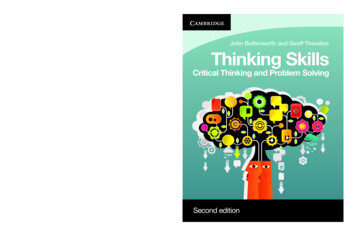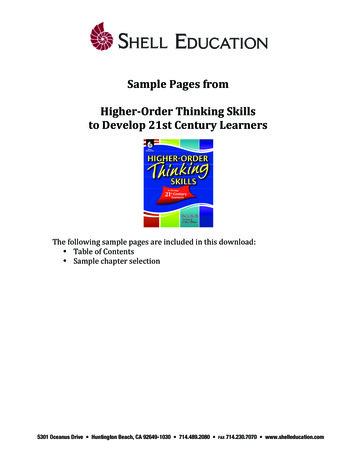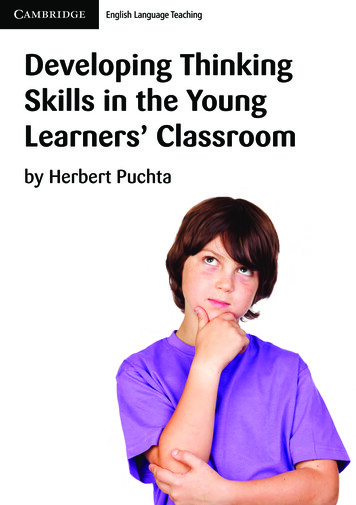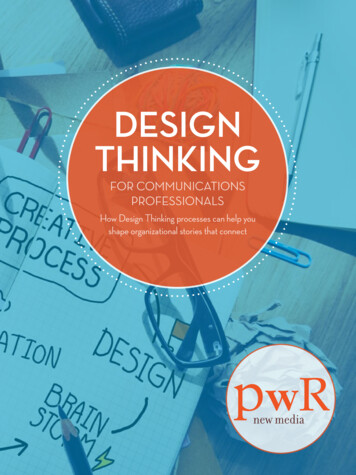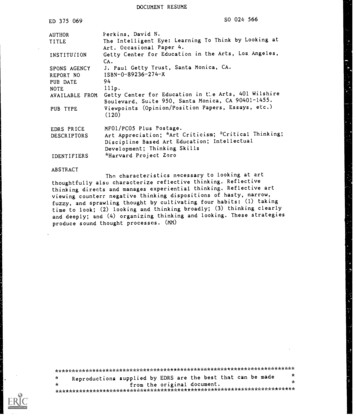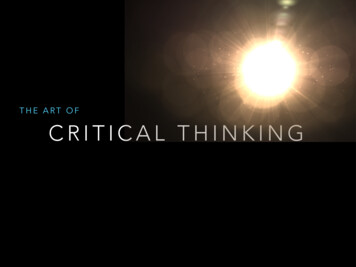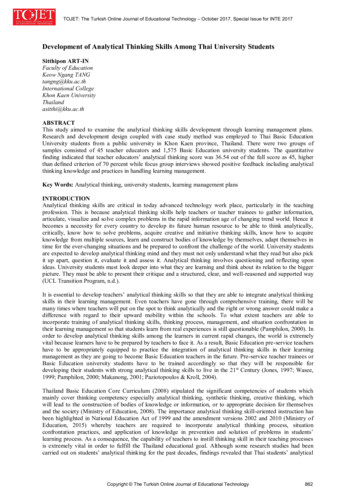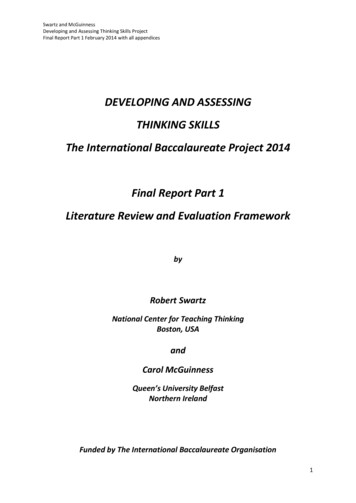
Transcription
Swartz and McGuinnessDeveloping and Assessing Thinking Skills ProjectFinal Report Part 1 February 2014 with all appendicesDEVELOPING AND ASSESSINGTHINKING SKILLSThe International Baccalaureate Project 2014Final Report Part 1Literature Review and Evaluation FrameworkbyRobert SwartzNational Center for Teaching ThinkingBoston, USAandCarol McGuinnessQueen’s University BelfastNorthern IrelandFunded by The International Baccalaureate Organisation1
Swartz and McGuinnessDeveloping and Assessing Thinking Skills ProjectFinal Report Part 1 February 2014 with all appendicesTable of ContentsPage1. The Purpose and Structure of the Final Report32. Framing Key Thinking Objectives for a Thinking Curriculum53. Positioning Thinking in the Curriculum164. Teaching Thinking: Principles and Practices215. Assessing Thinking: Principles and Practices446. Conclusion717. References728. Appendices842
Swartz and McGuinnessDeveloping and Assessing Thinking Skills ProjectFinal Report Part 1 February 2014 with all appendices1 The Purpose and Structure of the Final ReportIn this report we will address the two main topics identified in our initial proposal: The state of the art today with regard to identifying important and teachable kinds ofthinking, how they can be taught, and how they can be assessed. How the present IB programmes align with this picture.These topics will be addressed through a literature review, firsthand experience, and a documentanalysis of the IB curriculum materials that were available through the OCC. Using the literaturereview strategy outlined in the initial proposal (see Appendix 1), over 700 references were identifiedfor the time period 1998-2013, and these did not include the classic journal articles, texts and editedvolumes. While some up-to-date references were identified through the search, the general shapeof the field had not changed substantially from previous reviews conducted by the authors (e.g.,McGuinness, 2005). Thus, the following strategies guided the selection of references for this report.Four thinking-related constructs had been previously identified as the basis for the coding matrices –thinking processes (to include skills and strategies); metacognitive thinking; thinking dispositions;and beliefs about knowledge. The justification for identifying these specific constructs was informedby our previous knowledge of the research and practice literature and, for this report, we haveselected and organised the literature around these concepts. With the possible exception of beliefsabout knowledge and learning (mindsets and beliefs) - which we identified as a construct that is onlyemerging as important for teaching thinking - there is a general consensus that the other three arecentral to most theoretical approaches, albeit with different emphasis (for a recent overview, seeSchraw et al., 2011).Consequently, for the purposes of the report, we have focused on thinkingskills/strategies, metacognitive thinking and thinking dispositions.We noted that the IB programmes drew heavily on Bloom’s taxonomy (with some modifications)throughout their three programmes, and this prompted us to lead with a critical analysis of Bloom’sapproach and to offer alternative, though related, approaches as a way of making thinking moreteachable and assessable for the programmes.Finally, we have shaped the account of the literature to match our three-part analysis related to:(1) identifying desired thinking objectives for a thinking curriculum and how to frame theseobjectives to make them more teachable and subsequently assessable;3
Swartz and McGuinnessDeveloping and Assessing Thinking Skills ProjectFinal Report Part 1 February 2014 with all appendices(2) identifying an appropriate pedagogical approach for teaching thinking, together with specificteaching methods and techniques; and(3) identifying principles and models for assessing thinking that formatively support students’learning how to think more skillfully and that summatively assess their level of achievement. Thisthree part analysis is consistent with the notion of constructive alignment between curriculumobjectives, pedagogy and assessment (Biggs & Tang, 2011).Overall, our purpose is to create a research-informed and coherent framework for teaching andassessing thinking, to enable us to evaluate the IB programmes against the framework and to makerecommendations.With this purpose in mind, the report will be presented in two parts. The first part, Final Report Part1, consists of three sections, each related to thinking objectives, pedagogy and assessment. Eachsection will begin with a brief overview of key concepts and key approaches from the researchliterature and will then develop specific concepts and/or practices. Over the three sections, acoherent framework will be developed. The second part of the report, Final Report Part 2, will thenpresent our evaluations of the PYP, MYP and DP against the three part framework, using the codingmatrices as summary aids. Building on the evaluations, we will make both general recommendationsand recommendations specific to each IB programme.4
Swartz and McGuinnessDeveloping and Assessing Thinking Skills ProjectFinal Report Part 1 February 2014 with all appendices2 Framing Key Thinking Objectives for a Thinking Curriculum2.1 Different Theoretical Frameworks on Types of ThinkingThere are many different and sometimes competing theoretical frameworks to inform schools andteachers about what might be worth identifying as thinking objectives in a school curriculum. Forexample, Moseley et al. (2005), in a thorough review, analysed 41 different frameworks, which werethen further grouped into four categories. Although so many frameworks exist, not all of them havebeen well researched and/or have found their way into practical applications in schools andclassrooms on a wide scale.For our purposes, we have identified three traditions broadly definedby their disciplinary origins – education, philosophy, and psychology – and we have selectedframeworks as examples of each tradition.Originating from a dissatisfaction with the outcomes of students’ learning in higher education,Bloom’s taxonomy of six educational objectives (Bloom et al., 1956) – knowledge, comprehension,application, analysis, synthesis, and evaluation – is probably the best known framework. The finalfour objectives in the taxonomy have come to define “higher order thinking” and the movementfrom the first two goals (knowledge and comprehension) to the final four goals (application, analysis,synthesis, and evaluation) represents a shift from lower order thinking to higher order thinking.Thus, Bloom’s taxonomy, and more recent modifications (e.g., Anderson & Kratchwohl, 2001) havebecome a prevailing influence in the field of teaching higher order thinking and in moving students’learning away from rote memory and superficial understanding.In philosophy, and spilling into other fields, since 500 BC, there has been a continual and deepconcern with helping people think more clearly and critically. This has manifested itself in a traditionof Socratic questioning and the study and use of deductive logic to recognise – and correct – errorsin thinking. But as we move into the years after World War II in the 20th Century it is increasinglyrecognised that this approach is not effective and not nearly sufficient to have an impact onimproving the general thinking habits of our population. John Dewey, in the USA, was an earlyproponent of a different approach. In the post-war years, the figure that stands out as a leader inthis revisionist movement is Robert Ennis (1962, 1987, 1996, 2009, and 2011). Ennis’ contribution isto move away from the idea that learning to identify invalid arguments is at the core of criticalthinking and to identify a broader and more differentiated taxonomy of more positive thinkingobjectives in the form of a list of abilities as appropriate goals for a critical thinking curriculum.5
Swartz and McGuinnessDeveloping and Assessing Thinking Skills ProjectFinal Report Part 1 February 2014 with all appendicesWhile these do include abilities to do with the clarification and analysis of arguments, and assessingthe validity of arguments, they also include abilities at judging the credibility of sources, deductionand induction, evaluating value judgements, uncovering and challenging unstated assumptions, andsuppositional thinking. Ennis’ list of thinking abilities does change slightly in different publications,but these are good samples. All of these types of thinking characterize critical thinking – they needto be individually and collectively taught, learned and eventually mastered, if a student can be trulycalled a critical thinker.Another theoretical perspective on potential objectives for teaching thinking comes frompsychology. This can be traced to both cognitive psychology and developmental psychology.Whereas earlier analysis of cognitive functioning from a psychological perspective had focused onnotions of fixed intelligence, the new cognitive psychology of the 1970s introduced a more dynamicview of thinking as a flow of information through the cognitive system. Thus, good thinkers werethose with ‘strategies’ to manage their thinking more effectively, whether it be reading andcomprehending text materials,reasoning and testing hypotheses as in scientific thinking, orproblem-solving in specific domains such as mathematics. In other words, good thinkers were thosewho could exert some strategic control over their thinking. From this basic insight grew ideas aboutlearnable intelligence rather than fixed intelligence, and the focus shifted to cognitive strategies andheuristics, metacognition and self-regulation as important objectives for a thinking curriculum. Earlyexamples of this theoretical orientation included Feuerstein’s theory of cognitive modifiability(Feuerstein et al., 1980) and Sternberg’s Intelligence Applied (1986) based on his triarchic theory ofintelligence. Perkins’ (1995) commentary in his Outsmarting IQ identified an emerging science oflearnable intelligence (also, Perkins & Grotzer, 1997; Perkins, 2008).The idea of learnableintelligence is also prominent in more recent popular writings by Lucas and Claxton (2010) who talkabout a “new kinds of smart” and in theoretical work on why education needs a more ‘plastic’ viewof general ability (Adey et al., 2007)In addition to this perspective on learnable intelligence, more specific forms of thinking have beenthe focus for instruction, particularly problem-solving.Within the newly emerging research onproblem solving from a computational perspective (e.g., Newell & Simon, 1972), various stages inproblem solving were identified – identifying the problem, representing the problem, selecting anappropriate strategy, implementing the strategy, and evaluating solutions. In addition, a number ofimportant and general problem solving heuristics were found useful, such as identifying goals,means-end-analysis, setting up sub-goals, and working backwards, and these have formed the basisfor instructional texts (e.g., Hayes, 1989).Another important influence on the teachability of6
Swartz and McGuinnessDeveloping and Assessing Thinking Skills ProjectFinal Report Part 1 February 2014 with all appendicesproblem solving came from the work of Paul Torrance (see A Tribute to E. Paul Torrance in a specialissue of Creativity Research Journal, Kaufmann & Baer, 2006; and Treffinger et al., 2012) and fromOsborn, Parnes and Treffinger on what they called “creative” problem solving (summarised inIsaksen & Treffinger, 2004). A whole class of non-quantitative problem solving, including both everyday problem solving, and on-the-job problem solving, was the focus, and they developed specialcreativity-focused heuristic models with the aim of making the processes of creative problem solvingmore explicit.The emphasis on creative thinking and creativity focuses on the use of suchtechniques as brainstorming in generating possible solutions to problems, and especially skill atblending two or more familiar items or ideas to generate new and creative syntheses.Drawing on this broad range of research from cognitive psychology and beyond, Halpern (1984, 1stedition; 2013, 5th edition) has created a taxonomy that embraces not only argument analysis, butalso hypothesis testing skills, probabilistic reasoning, problem-solving, decision-making and creativityand her work is accompanied by instructional texts and manuals, aimed primarily at high school andcollege level students (Halpern & Riggio, 2003). And the infusion program developed by Swartz andcolleagues (“Thinking-Based Learning”) have also drawn upon these three traditions to create acomprehensive set of thinking objectives, primarily focusing on the development of skillful thinking,but also incorporating an adjunct set of objectives relating to thinking dispositions (Swartz et al.,2007). They have also produced collections of infusion lessons from teachers in elementary andsecondary schools who practice this approach (e.g., Swartz et al., 1994, 1998, 2000a, 2000b, 2000c).In conclusion, although Bloom’s taxonomy can be said to be a prevailing influence on what is nowunderstood as higher order thinking skills, the different origins and theoretical approaches that wehave just outlined expand the range of types of thinking that might be desirable to pursue aseducational goals in a thinking curriculum and introduces newer concepts related to metacognition,thinking dispositions and self-regulation.For the moment, because of the prominent place that Bloom’s taxonomy currently occupies in the IBprogrammes, we shall make this framework the focus for closer analysis in the next section, in orderto develop a better understanding of the nature of skillful thinking. We shall return to some of theother concepts such as problem-solving, metacognition and thinking dispositions in later sections.7
Swartz and McGuinnessDeveloping and Assessing Thinking Skills ProjectFinal Report Part 1 February 2014 with all appendices2.2 Broad vs. Differentiated Types of Thinking ObjectivesAlthough many educators describe their objectives in teaching thinking in a variety of different ways,in this section two alternative approaches, Bloom and Ennis, will be compared, with the ultimateintention of framing thinking objectives in a manner that make them more teachable.Bloom’s six goals are broadly framed, while Ennis has generated a more differentiated taxonomywith specific reference to critical thinking. We do not view these two ways of articulating the goalsof teaching thinking as either incompatible or mutually exclusive. There is not any one type ofthinking activity that we do that counts as analysis. There are different ways of analysing something.For example, analysing how an object’s parts contribute to what it is or does (e.g., wheels on a carfunction to make it move quickly), or becoming aware if an object’s characteristics and what havingthese characteristics implies (e.g., glass blowing generates great heat, hence there is a danger tohumans), or analysing what follows from something being classified a certain way (e.g., nutritiousimplies that it can benefit humans who eat it).The same multiplicity of different ways of synthesizing things, or of conducting an evaluation of anidea, yields the same multiplicity of sub-categories under each of the Bloom designations. To be agood thinker vis-à-vis analysis, synthesis, or evaluation has its cash value in identifying a number ofdifferent types of thinking that fall into each category, all perhaps with the same overall goals, buteach of which needs to be mastered if a person is to become a good thinker. The insight of RobertEnnis is the need to make these explicit in an organised way and taught separately if we are to do agood job of helping students learn how to evaluate ideas – that is, think critically.Indeed, we should add here that many teachers, who start with the use of Bloom’s Taxonomy, orone of its more recent derivatives or modifications, tend to gravitate, in instruction, to more specifictypes of thinking that fall under each category. For example, comparing and contrasting is oftenintroduced as a mode of analysis, as is articulating the structure of an argument.Supplementing Bloom’s Taxonomy with a systematic list of different ways that each of the broadertypes of thinking can be done is a model for making sure that thinking instruction aims at all of theimportant varieties of thinking in each of the Bloom categories (and the IB Command Termsdocument recognises this).Based on Swartz’ own work (Swartz & Parks, 1994; Swartz et al., 2007) here is a way of combiningthese two approaches to stating the objectives of teaching thinking. Note that although the8
Swartz and McGuinnessDeveloping and Assessing Thinking Skills ProjectFinal Report Part 1 February 2014 with all appendicesobjectives are more differentiated, they remain grouped under three of Bloom’s higher orderthinking headings.But even these categories may not be sufficient. Because of their prominence in other frameworks,it might be important to consider both decision making and problem solving, as many people do notdo these very well and students can be taught to do them more skillfully. Hence we may want toadd another category to the above list:IV Complex ThinkingProcesses1.Decision Making2.Problem Solving2.3 The Elusive Nature of Thinking SkillsWe now turn to another complexity with regard to framing objectives for a thinking curriculum.There is an almost universally accepted presumption in both the theory and practice of teachingthinking that our main objective is to teach students thinking skills that students can then use tothink beyond mere memory when engaging with curricular content. Both when the Bloomcategories are taken as the primary goals of teaching thinking or the more finely tuned Ennis-type9
Swartz and McGuinnessDeveloping and Assessing Thinking Skills ProjectFinal Report Part 1 February 2014 with all appendicescategories, each are often taken as defining the list of thinking skills that we need to teach studentsto become better thinkers. Thus analysis from Bloom’s taxonomy is often described as a thinkingskill. Judging the reliability of a source is taken to describe a thinking skill. And there are otherthinking activities like these that are often described as thinking skills as well – the range of otherBloom categories and from those who focus on more specific types of thinking like those advocatedby Ennis, comparing and contrasting, classifying, sequencing, predicting, etc. often get added.Whichever of these two approaches to stating the primary goals of teaching thinking are adopted,the way this translates into both instruction and assessment is to use words like these as explicitprompts to bring out these kinds of thinking. But there is a different view of what a thinking skill is.This other view affirms that what are described in these classifications are NOT ‘thinking skills’. Thisclaim takes seriously a distinction made in Ennis’ later work. There, judging the credibility of asource is again identified as something that critical thinkers need to be able to do. But Ennis suggeststhat such an activity needs to be manifested in a “strong performance”, and that occurs only whencertain criteria defining how to judge the credibility of a source are well satisfied, for example, thatthe “expertise” and “reputation” of the author needs to be considered, that “establishedprocedures” are used, that there is “agreement with other sources” and so on. So we might, as astarter, want to say that to exercise skill at judging the credibility of a source we should ask andanswer the following questions, and judge credibility based on the answers:Judging the Credibility of a Source SkillfullyWhat is the expertise of the source?What is the source’s reputation with regard to this kind of information?Did the source use established procedures in getting the information?To what extent do other sources confirm what the source tells us?Perhaps this can be refined even further, but it is enough to make an important point, if we followEnnis’ reasoning. Judging the credibility of a source is not, strictly speaking, a “critical thinking skill”,but rather a way to engage in critical thinking that can be done with skill but also in rather superficialways. So learning how to do it with skill and exercising that skill in a habitual way is, more strictlyspeaking, what a thinking skill is.This applies to all of the other types of thinking included in the chart above as well as, especially,decision making and problem solving, where examples of making decision and solving problems insloppy non-thoughtful ways are frequently encountered.10
Swartz and McGuinnessDeveloping and Assessing Thinking Skills ProjectFinal Report Part 1 February 2014 with all appendices2.4 Metacognition as an Objective in a Thinking CurriculumIn an earlier section, we identified the idea of a person having strategic control of their thinking asone characteristic that has come to define high quality thinking. The term, metacognition (‘meta’means ‘going beyond’), was introduced by Flavell (1979) to capture the notion of cognitivemonitoring and related metacognitive processes, though the concept can be traced back to earlierwriters (e.g., Dewey).Metacognition now occupies such a central place in many theoreticalframeworks for cognitive development (Kuhn, 2000, 2008, 2009) that we suggest that it can now betreated as a thinking objective in its own right.The term is often used interchangeable with‘thinking about thinking’ and it certainly does involve an act of reflection. But in the context oflearnable intelligence it has a more precise meaning with regard to the ‘thinking’ that is the object ofthe reflection.In the psychological literature, metacognition generally refers to twocomplementary strands (1) knowledge about cognition – about cognition in general and one’s owncognition - involving some degree of awareness; and (2) self-regulation or the ability to plan, tomonitor and adjust one’s thinking in relation to task demands and to evaluate thinking outcomes(Flavell, 1979; Brown, 1987; Kuhn, 2000). Thus, in order to be able to plan and adjust one’sthinking, learners need to be aware of their own thinking processes, and the classroom techniquesthat make thinking more visible are a necessary first step in helping thinking become moremetacognitive. A more precise meaning might be: knowing about thinking strategies in general; becoming aware of one’s own thinking strategies; reflecting on and evaluating one’s own thinking strategies with the intention to plan and direct future thinking in more skillful ways.This meaning is at the heart of the notion of learnable intelligence.The expectation is that thestudent will eventually internalise the more skillful thinking and use it spontaneously in futurecontexts. Thus the instructional goal of metacognitive thinking – to help the learner become moreself-regulated – will be achieved. There is growing body of evidence that approaches to teachingthinking that adopt a metacognitive perspective are more successful than those that rely on merelypractising cognitive strategies.In a meta-analytic review of 29 well-designed evaluations of theeffects of thinking skills interventions on a range of learning outcomes (reasoning tests, curricularattainments and attitudinal measures), Higgins and his colleagues (Higgins et al., 2005) reported thatmetacognitive interventions had a more positive effect on the students’ learning compared to theaverage effect reported across all the interventions. In quantitative terms, the learning outcomes11
Swartz and McGuinnessDeveloping and Assessing Thinking Skills ProjectFinal Report Part 1 February 2014 with all appendicesassociated with the metacognitive interventions were 95% of a standard deviation higher thancontrol groups, compared to 62% of a standard deviation higher than control groups for thinkingskills interventions more generally.So, both for its theoretical relevance and practical importancein contributing to students’ learning, metacognition merits treatment as a thinking objective.Thediagram below illustrates how metacognition was included in the thinking objectives for the ACTS(Activating Children’s Thinking Skills) programme in Northern Ireland (McGuinness et al., 2006),objectives derived in part from the earlier work of Swartz and Parks (Swartz & Parks, 1994). Theway in which the metacognitive component is outlined differently (in a bubble) than the cognitivecomponents (in a rectangle) is intended to communicate that metacognition has a different status asan objective compared to the other forms of higher order thinking that are represented in themodel, acting as it does as an appraiser, monitor and adjuster of the other thinking objectives in themodel.2.5 Thinking Dispositions as Objectives for a Thinking CurriculumIn How We Think (1933), after advocating that we teach students strategies for what he called“reflective thinking” (in 21st century terms, critical thinking), John Dewey said “You can teachstudents how to think reflectively, but if they don’t care about doing this, they won’t”. This is acomment made earlier by William James, and by J. J. Rousseau. And indeed, this problem is12
Swartz and McGuinnessDeveloping and Assessing Thinking Skills ProjectFinal Report Part 1 February 2014 with all appendicesreflected in a set of approaches that stresses the need to teach “Thinking Dispositions”1 (Ennis,Perkins, Ritchhart and colleagues) or “Habits of Mind” (Costa and Kallick, and colleagues) as well asthinking skills. Let us make some comments about this idea that, besides thinking skills, it isimportant to teach students certain thinking dispositions if we are aiming at helping them becomegood thinkers.Efforts to teach students thinking skills aim at helping students not only learn how to manifest theseskills, but also to developing the habit of doing so when called for through continued practice andsensitivity to where these skills are needed. “Internalization’, which we will discuss in greater lengthlater, is a goal in teaching thinking, with metacognitive thinking as a means for self-management andself-regulation. These practices all contribute to building the habit of thinking well. So in a sense wewant our students to develop the habit/disposition to think about options and consequences whenthey make decisions. But what various researchers have called “thinking dispositions” are more thanwhat we have just described.Doing something skillfully when you are trying to do it is important but why try? Trying presupposesthat the person is motivated to do a kind of thinking well – that there is an initial “push” to engage init and an inclination to continue to engage in a regular way. Thus, what many have called “thinkingdispositions” are not just the habitual use of a skill, but more like character attributes, attitudes orvalues that incline us to exercise skill at thinking when it is called for. To help students develop theseseems to require something different from teaching thinking skills.Robert Ennis was the first contemporary author to make note of the need to teach these in his workand he identified several dispositions that he considered important for critical thinking – the desirefor clarity, to understand other points of view and be understood; to be truth-seeking; to be openminded and seek alternatives; to be precise (Ennis, 1987, 1996). He points out that not only do weneed to be able to think skillfully but we also need to have the inclination to do it regularly, andthese dispositions represent what provides such an inclination. The distinction between thinkingskills and thinking dispositions was further confirmed in an expert consensus statement on criticalthinking for the purposes of education and assessment, published by the American PhilosophicalAssociation (The Delphi Report, Facione, 1990). The statement pointed to a range of what they1A related concept called ‘learning dispositions’ has been discussed at length by Carr and Claxton (2002).Their development of the idea of disposition is very similar to that which is discussed in this section, but thetype of dispositions they reference relate to much broader orientations to learning than those that are thefocus of thinking dispositions. For example, their learning dispositions are resilience, playfulness andreciprocity.13
Swartz and McGuinnessDeveloping and Assessing Thinking Skills ProjectFinal Report Part 1 February 2014 with all appendicescalled ‘affective dispositions for critical thinking’ such as inquisitiveness, open-mindedness, honestyin facing one’s own biases and prejudices, fair-mindedness and so on.Perkins and his colleagues (Perkins, Jay, & Tishman, 1993) have explored the sense in whichexercising a thinking skill or ability can become habitual/dispositional. The active use of thinkingskills has three components – inclinations, sensitivities and abilities. Each of these can be taught andcan be an objective for a thinking curriculum. For example , as we have remarked, reflection ondecision making leads to knowing how to make a decision (ability/skill), but to be a good decisionmaker a person must also be alert to occasions on which decisions need to be made (sensitivity) andmust also be generally inclined towards making decisions and taking responsibility for decisionmaking (inclination).In addition, Perkins has identified seven broad thinking dispositions – thinking motivators: to bebroad and adventurous; to be curious and oriented towards problem-finding; to seek understandingand build explanations; to be planful and strategic; to be intellectually careful; to seek and evaluatereasons; and to be metacognitive. To date there is no consensus between En
suppositional thinking. Ennis list of thinking abilities does change slightly in different publications, but these are good samples. All of these types of thinking characterize critical thinking - they need to be individually and collectively taught, learned and eventually mastered, if a student can be truly called a critical thinker.



